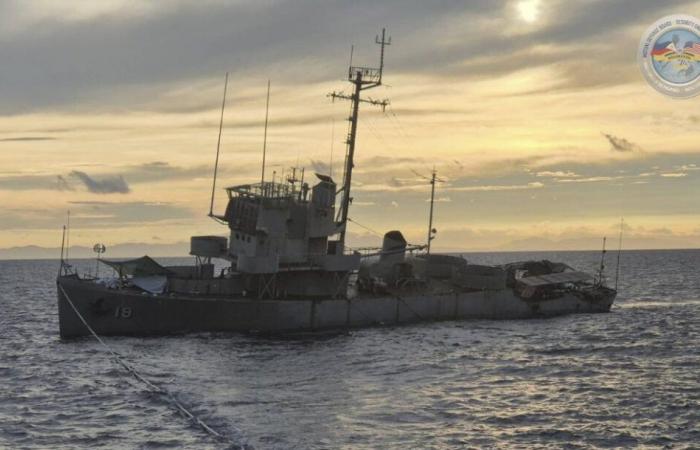Manila, the Philippines (AP) – A ship from the Philippine Navy of the Era of World War II that was going to be used as a goal in combat maneuvers by US and Philippines forces sank on Monday before the simulated assault, which led to cancel the exercise, according to military officials of the United States and the Philippines.
The BRP Miguel Malvar, which was removed from the service by the Filipina Navy in 2021, made waters while towing in agitated waters in front of the disputed South China Sea and sank about 30 nautical miles (55 kilometers) of the Western Filipina province of Zambales. There was no one on board when the ship leaned and then sank, the Filipino army reported.
The US and Philippine forces would continue with other real fire maneuvers against Zambales on Monday despite the premature sinking of Malvar. The ship was built as a patrol vessel for the United States Navy in the 1940s and was transferred to the Vietnam Navy before the Philippine Army acquired it, said the captain of the Navy Filipina John Percie Alcos.
“It is a deteriorated boat of 80 years and could not bear the agitated seas,” said Lieutenant Colonel Filipino John Paul Salgado to The Associated Press.
The ship’s sinking exercise was planned in an area in front of the very disputed Scarborough Bank, which has been closely guarded by the Chinese Coast Guard, the Navy and ships that are believed to manned militias.
The Philippines also claims the Atolón, a fishing area that is about 220 kilometers (137 miles) west of Zambales. Chinese and Philippines have had increasingly hostile clashes in Scarborough’s waters and airspace in recent years.
The canceled ship sinking maneuvers would have been the thirds organized by the treaties in recent years. It was supposed to be one of the outstanding points of the large -scale annual military exercises in the United States and the Philippines, organized from April 21 to May 9 with approximately 14,000 participants of US and Philippines.
Called Balikatan, which in Tagalo means shoulder shoulder, the combat exercises have focused more and more on the defense of Filipino sovereignty before China’s growing aggressiveness in the South China Sea, which Beijing claims practically in its entirety.
The simulated battle scenes that have been carried out so far, including the recovery of an island of hostile forces, have reflected the guarantees of the Trump government, expressed by the Secretary of Defense, Pete Hegseth, that the United States would fulfill its commitment to defend Philippines in case the Philippine Forces are attacked, even in the South China Sea.
On Sunday, US forces, Australian and the Philippines practiced the recovery of an island of hostile forces in the coastal city of Balabac in the western province of Palawan, next to the South China Sea.
Japanese forces and British marines participated as observers of the combat exercise, which “demonstrated the growing interoperability and cohesion between partner nations in the maintenance of regional security,” said Salgado.
“What we have seen since Trump returned to the White House is a notable level of continuity in the alliance between the United States and the Philippines not only in joint military exercises, but also in US statements that the alliance is’ unwavering,” said Derek Grossman, a senior defense analyst at Rand Corporation.
“The Trump government is trying to maintain pressure on China through its support for the Philippines,” said Grossman, but added that it is not clear “how sustainable this commitment will be since the Trump government seems less belligerent with China than its predecessors.”
China has vehemently opposed such exercises that involve US forces in or near the Sea of South China or Taiwan, a self -governor democratic island that Beijing claims as a province and has threatened to annexal by force if necessary.
However, military officials from the United States and the Philippines have insisted that the combat exercises were not designed thinking about China, but serve as a deterrent to acts of aggression in the region.
___
This story was translated from English by an AP editor with the help of a generative artificial intelligence tool.






